Please tell me how I can solve the following problem: I need to implement a dynamically created menu with different nesting levels depending on the data model object. At the moment, using recursion, we managed to create the menu as such, however, there is a problem of assigning the attribute [matMenuTriggerFor] for, directly, the submenu. The problem is that all subsequent submenus in fact refer to the very first, so when you hover over any of the submenus, it causes a "flip" to the original one (example on image: menu, which includes elements: Device, Extension, Queue, Queue member (with submenu elements)). Thus, for a fraction of seconds, I see the other submenu frame (example on image: submenu Grouped list), after which the very first becomes active. Of course, maybe I didn’t do everything right, so I’m turning here. Help me please. Thank you all.
imenu-item.ts
export interface IMenuItem {
name: string | string[];
link: string;
subItems: IMenuItem[];
}
dynamic-menu.service.ts
import {Inject, Injectable} from '@angular/core';
import {APP_CONFIG_ROUTES} from '../../../config/routes/app.config.routes';
import {IAppConfigRoutes} from '../../../config/routes/iapp.config.routes';
import {IMenuItem} from './imenu-item';
import {_} from '@biesbjerg/ngx-translate-extract/dist/utils/utils';
@Injectable({
providedIn: 'root'
})
export class DynamicMenuService {
private readonly appConfig: any;
constructor(@Inject(APP_CONFIG_ROUTES) appConfig: IAppConfigRoutes) {
this.appConfig = appConfig;
}
getMenuItems(): IMenuItem[] {
return [
{
name: _('labels.device'),
link: '/' + this.appConfig.routes.device,
subItems: null
},
{
name: _('labels.extension'),
link: '/' + this.appConfig.routes.extension,
subItems: null
},
{
name: _('labels.queue'),
link: '/' + this.appConfig.routes.queue,
subItems: null
},
{
name: _('labels.queueMember'),
link: null,
subItems: [{
name: _('labels.fullList'),
link: '/' + this.appConfig.routes.queueMember.all,
subItems: null
}, {
name: _('labels.groupedList'),
link: '/' + this.appConfig.routes.queueMember.grouped,
subItems: [{
name: 'subName',
link: 'subLink',
subItems: [{
name: 'subSubName1',
link: 'subSubLink1',
subItems: null
}, {
name: 'subSubName2',
link: 'subSubLink2',
subItems: null
}]
}]
}]
}
];
}
}
dynamic-menu.component.ts
import {Component, Input, OnInit} from '@angular/core';
import {IMenuItem} from './imenu-item';
@Component({
selector: 'app-dynamic-menu',
templateUrl: './dynamic-menu.component.html',
styleUrls: ['./dynamic-menu.component.scss']
})
export class DynamicMenuComponent implements OnInit {
dynamicMenuItemsData: IMenuItem[];
constructor(private dynamicMenuService: DynamicMenuService) {
}
ngOnInit() {
this.dynamicMenuItemsData = this.dynamicMenuService.getMenuItems();
}
}
dynamic-menu.component.html
<div>
<ng-container [ngTemplateOutlet]="recursiveListMenuItems"
[ngTemplateOutletContext]="{$implicit: dynamicMenuItemsData}">
</ng-container>
</div>
<ng-template #recursiveListMenuItems let-listMenuItems>
<div *ngFor="let menuItem of listMenuItems">
<ng-container [ngTemplateOutlet]="menuItem.subItems != null ? subMenuItem : simpleMenuItem"
[ngTemplateOutletContext]="{$implicit: menuItem}">
</ng-container>
</div>
</ng-template>
<ng-template #simpleMenuItem let-menuItemArg>
<a class="mat-button"
mat-menu-item
routerLink="{{menuItemArg.link}}">
<span>{{menuItemArg.name | translate}}</span>
</a>
</ng-template>
<ng-template #subMenuItem let-menuItemArg>
<a class="mat-button"
mat-menu-item
routerLink="{{menuItemArg.link}}"
[matMenuTriggerFor]="subItemsMenu">
<span>{{menuItemArg.name | translate}}</span>
<mat-menu #subItemsMenu="matMenu"
[overlapTrigger]="false">
<ng-container [ngTemplateOutlet]="recursiveListMenuItems"
[ngTemplateOutletContext]="{$implicit: menuItemArg.subItems}">
</ng-container>
</mat-menu>
</a>
</ng-template>
